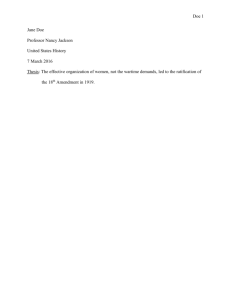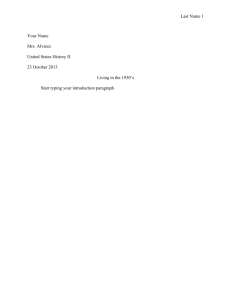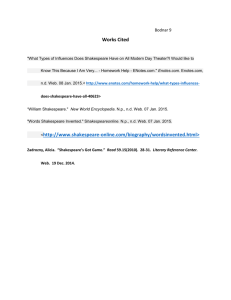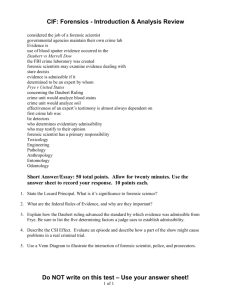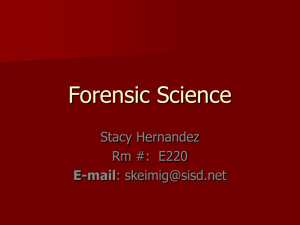Shelby's Defense slides
advertisement
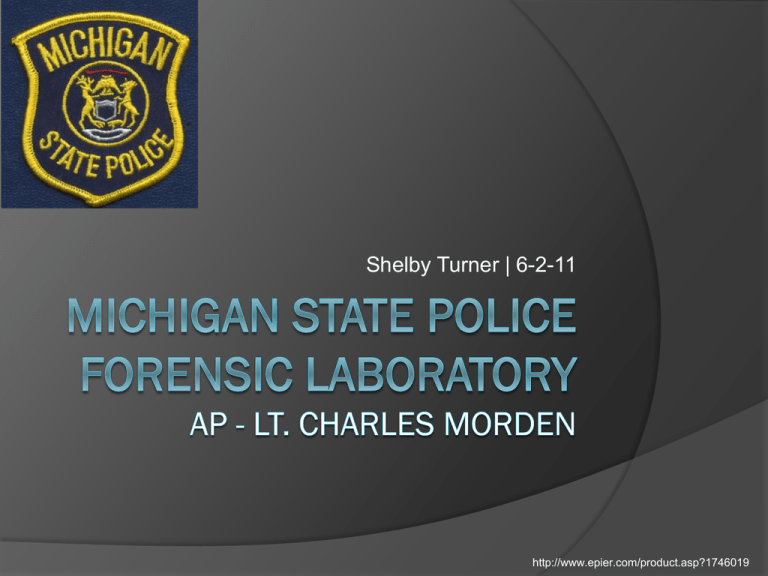
Shelby Turner | 6-2-11 http://www.epier.com/product.asp?1746019 Why… Always interested in Forensics I Love: ○ CSI ○ Criminal Minds ○ NCIS ○ Etc. Narrowed my careers to two Chemical Engineer Forensic Scientist office.microsoft.com What I learned… What it is like in the “real world” and the workplace How to log new evidence The different units in the lab What the trace unit analyzes What it’s like to work with others Not everything revolves around my schedule office.microsoft.com What I did… Worked at the front desk Logged evidence Observed in the trace unit Chain of custody Worked on training guide For future interns Worked on database product My Product Purpose To categorize/organize known evidence Easier to make comparisons Needed for certification Intended Audience Northville Trace Unit Other forensic labs My Product Key 1 = Hairs 2 = Fibers Identifier Category Description 3 = Paint/ Pigments 1-1 1-2 1-3 Animal Animal Animal Mink - gray phase, guard Mink - gray phase body Mink - gray phase , belly 4 = Glass 5 = Feathers 6 = Explosives 7 = Polymers 1-4 1-5 1-6 Animal Animal Animal Mink - brown phase , guard Mink - brown phase , body Mink - brown phase , belly 2-119 2-120 2-121 2-122 Natural Natural Natural Natural 2-123 2-124 2-125 2-126 Natural Natural 8-66 Leather 8-67 8-68 8-69 8-70 Drano Breast Implant Breast Implant Duct Tape 8 = Miscellaneous 9 = Sets Source Flax Tossa Meshta (or Kenaf) White Jute Ramie (degummed) Flax - Water Ret Flax Nylon 501, filament Kodel - Polyester Unknown substance in murder case Sets ID Ludlow Corporation Ludlow Corporation Ludlow Corporation Ludlow Corporation Ludlow Corporation Ludlow Corporation E. I. du Pont de Nemours Eastman Chemical 9-7-1 Commercial Furs 9-8-2 Commercial Fibers 9-9-2 Synthetic and Manufactured Fibers 9-10 Chemical compounds Research Question What is Trace Evidence and why is it important in criminal investigations? Why I chose this question: Different sources Learn more about Practicum General question My Answer What is trace? It is the miscellaneous evidence ○ Footprints ○ Hairs ○ Fibers How is it important? Can provide a solution when blood doesn’t Creates connections between ○ Suspect – victim – crime scene office.microsoft.com AP Answer Crime shows are not realistic Takes a long time to analyze evidence Trace unit analyzes what others don’t Unknown chemical compounds -> footprints -> rare animal hairs 1-210 1-211 1-212 1-213 1-214 1-215 1-216 Animal Animal Animal Animal Animal Animal Animal Hyena - Spotted Grysbok Impala Llama - various natural colors Eland Buffalo Chinchilla “When we are given hairs...” (Morden) CSI – Trace Unit Trace and Blood analysis Found a new suspect (Zuiker) (Hoyt) Locard’s Exchange Principle He stated: • There is always proof • A cross-transfer • Can’t be removed • “It is impossible for a criminal to act…” Usually microscopic office.microsoft.com (“Locard’s Exchange Principle”) Hairs Trace is most often small It is almost impossible to clear away from a crime scene (“Trace Evidence”) The most common type of evidence analyzed by the trace unit is hairs (Morden) We lose 50-100 daily (“Hair Loss”) office.microsoft.com Fibers 3 types: • Natural, Synthetic, Derived (de Forest, 192) • Most common is cotton • Useful when dyed (de Forest, 194) • Connection of rare blue fibers in a crime office.microsoft.com The Tests Refractive Index: Is done using a polarized light microscope Measures the amount of refractive light (Petraco, 77) Spectroscopy Measures the, “absorption, scattering, or emission of electromagnetic radiation by atoms or molecules” (“Spectroscopy”) Chromatography Measures the “stickiness” of compounds Allows for multiple source testing (“Chromatography”) The Tests Spectroscopy http://www.ap.stmarys.ca/~ishort/Astro/ Chromatography http://www.dnassequencing.com/2011/04/16/chromatography/ Efficiency & Accuracy Catch the “bad guy” quickly All evidence > just fingerprints More likely the suspect is guilty Imagine a case: ○ Woman is found dead on couch ○ Fingerprints = her friend ○ Friend has no alibi = friend is guilty ○ STOP ○ Gray fibers under fingernails ○ From husband’s gray shirt ○ HUSBAND IS GUILTY Case of Brandon Mayfield Case: Train Bombing in Madrid Suspect: Brandon Mayfield Evidence: Latent Print Warrant Granted Not his Fingerprint “According to the British standard…” “However…” (“crime”) Detection of Crime • Reported by civilian and police Investigate Forensic Investigators analyze scene The path of a crime • Evidence collection and documentation Suspect is determined • Based on witnesses, type of crime, and motive Evidence is used to connect suspect to crime • Evidence undergoes different tests Suspect is interrogated about evidence found • Often investigators get a confession Case goes to trial • Suspect found guilty (“crime”) Conclusion Research question: What is trace evidence and why is it important in criminal investigations? Answer: Usually microscopic Occurs with contact Proves a connection ○ When DNA and blood don’t Is efficient and accurate Conclusion What I learned: That forensic science is not for me That SMP helped me: ○ Prepare for future ○ Prepare for workplace Future goals: U of M Chemical Engineering Master’s Degree Study abroad Work for a major corporation: ○ Maybe pharmaceuticals Bibliography “crime.” Encyclopaedia Britannic.Encyclopaedia Britannica, 2011.Encyclopaedia Britannica Online.Web. 29 Apr. 2011. <http://www.britannica.com/EBchecked/topic/142953/crime>. “Crime Scene Investigation.”World of Forensic Science.Ed. K. Lee Lerner and Brenda Wilmoth Lerner. Gale Cengage, 2006. eNotes.com. 2006.Web. 29 Apr. 2011. <http://www.enotes.com/forensic-science/crime-scene-investigation>. De, Forest Peter R., R. E. Gaensslen, and Henry C. Lee. Forensic Science: an Introduction to Criminalistics. New York: McGraw-Hill, 1983. Print. “Fibers.”World of Forensic Science.Ed. K. Lee Lerner and Brenda Wilmoth Lerner. Gale Cengage, 2006. eNotes.com. 2006.Web. 29 Apr. 2011. <http://www.enotes.com/forensic-science/fibers>. “Forensic Science.”World of Forensic Science.Ed. K. Lee Lerner and Brenda Wilmoth Lerner. Gale Cengage, 2006. eNotes.com. 2006.Web. 29 Apr. 2011. <http://www.enotes.com/forensic-science/trace-evidence> Gardner, Edward. "Using a Reflected Ultraviolet Imaging System to Recover Friction Ridge Impressions on Post-Blast Material." Journal of Forensic Identification. Vol. 60. International Association for Identification, 2010. 104-18. Print. Bibliography "Hair Loss." American Academy of Dermatology.American Academy of Dermatology, 2011.Web. 4 May 2011. <http://www.aad.org/skin-conditions/dermatology-ato-z/hair-loss>. Houck, Max M. Mute Witnesses: Trace Evidence Analysis. San Diego, Calif: Academic, 2001. Print. Houck, Max M. Trace Evidence Analysis: More Cases in Mute Witnesses. Amsterdam: Elsevier Academic, 2004. Print. Hoyt, Jacqueline. "Death and the Maiden." CSI: Crime Scene Investigation. Prod. Jerry Bruckheimer. Dir. Brad Tanenbaum. CBS. WWJ-TV, 5 Nov. 2009. Youtube.com. 6 Nov. 2009. Web. 17 May 2011. “Locard’s Exchange Principle.” World of Forensic Science.Ed. K. Lee Lerner and Brenda Wilmoth Lerner. Gale Cengage, 2006. eNotes.com. 2006.Web. 29 Apr. 2011. <http://www.enotes.com/forensic-science/locard-s-exchange-principle>. Morden, Charles, Cheryl Lozen, and Heidi Bonta."Adult Partner."Personal interview. 29 Mar. 2011. Petraco, Nicholas, and Thomas Kubic. Color Atlas and Manual of Microscopy for Criminalists, Chemists and Conservators. Boca Raton: CRC, 2004. Print. Bibliography “Physical Evidence.”World of Forensic Science.Ed. K. Lee Lerner and Brenda Wilmoth Lerner. Gale Cengage, 2006. eNotes.com. 2006.Web. 29 Apr. 2011. <http://www.enotes.com/forensic-science/physical-evidence>. “Spectroscopy.”World of Forensic Science.Ed. K. Lee Lerner and Brenda Wilmoth Lerner. Gale Cengage, 2006. eNotes.com. 2006.Web. 29 Apr. 2011. <http://www.enotes.com/forensic-science/spectroscopy>. “Thin Layer Chromatography.”World of Forensic Science.Ed. K. Lee Lerner and Brenda Wilmoth Lerner. Gale Cengage, 2006. eNotes.com. 2006.Web. 29 Apr. 2011. <http://www.enotes.com/forensic-science/trace-evidence>. “Trace Evidence.”World of Forensic Science.Ed. K. Lee Lerner and Brenda Wilmoth Lerner. Gale Cengage, 2006. eNotes.com. 2006.Web. 29 Apr. 2011.<http://www.enotes.com/forensic-science/trace-evidence>. Zuiker, Anthony E. "If I Had a Hammer." CSI: Crime Scene Investigation. Dir. Brad Tanenbaum. Prod. Jerry Bruckheimer. CBS. WWJ-TV, 23 Apr. 2009. Youtube.com. 28 Apr. 2009. Web. 16 May 2011.
